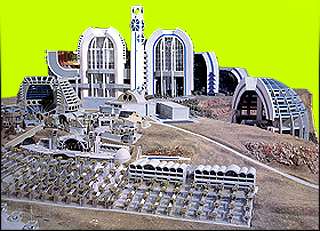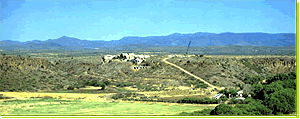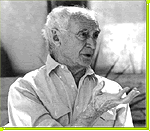
Seventy miles north of Phoenix, perched on the edge of a stark plateau above a gnarled desert ravine, lies a bud of visionary urban futurism. Looking like nothing so much as the ultimate Star Trek village, Arcosanti (current pop. 50) is the cemented dream of 80-year-old Italian architect Paolo Soleri, who studied with the great Frank Lloyd Wright before plunging into Buckminster Fuller territory in the 1960s.
Visions of Arcosanti
Soleri's 1969 book Arcology: The City in the Image of Man has been recently republished by Bridgewood Press and it's worth every penny of its hefty cover price. The designs show comic-book slices of dense, intricate SciFi cities, urban jewels that are compact, honeycombed, and refreshingly devoid of fucking automobiles.

Framed by Soleri's idiosyncratic philosophical prose, the designs leap off the page as real possibilities, not just whims or abstract experiments, but blueprints for an evolved form of human social life. And though you might not want to live inside one of these technorganic beehives, you'd certainly want to visit.
Luckily, you can. To his lasting credit, Soleri wasn't content to keep his designs locked up in his diagrams. In the early 1970s, he laid actual foundations in Arizona. At that time, communal experiments were all the rage and the desert landscape seemed the ideal place to redesign human community.
For a futuristic visionary, Soleri remains very much a modernist, and a rather conservative one at that. As William Irwin Thompson points out in Passages About Earth, Soleri had little truck with hippie utopians. His work reflected a faith in the collective organic process that was way more Catholic mystic than hippie freak. For all the attention (and followers) he attracted, Arcosanti never managed to plug into the serious capital flows necessary to complete his 40-acre dream, let alone support (and exploit) the work of other creative visionaries.
Today, the income for the site still depends significantly on the bronze windbells and other future-primitive artifacts that are cranked out of Arcosanti's foundry and sold around the world. There's a melancholic, monastic vibe to the place, although young transients still go there in search of practical skills and spiritually-fulfilling labor. Only a tiny slice of Soleri's envisioned city has been incarnated. Construction has proceeded at a glacial pace of late, and the population is lower than it has been in years. To an outsider, Arcosanti seems to be in extended drift.
Revisions of Arcosanti
But things may be changing. The recent Paradox conference, convened at Arcosanti, was at least partly an attempt to bring new energy to the place. Following on the heels of an earlier gathering held two years ago, Paradox II drew together a crackling crew of liquid architects, theoryheads, de Chardin scholars, VR honchos, New-Age physicists, and brainiac psychedelic media fiends... and yours truly.
While the general theme was "cyberspace embodied" -- that is, how we can link the evolving possibilities of digital media into the real spaces where we live -- the underlying theme of Paradox II was to see how new media could revitalize Arcosanti.  Contemporary architectural seers like Marcos Novak, Stephen Perrella, and Peter Anders showed how the new informational and conceptual zones opened up by digital multimedia were mixing up built space with new "hypersurfaces" and "transarchitectures." These zones, at once theoretical and perceptual, are making room for a digital refresh of some of Soleri's ideas, which themselves are still more virtual than embodied.
Contemporary architectural seers like Marcos Novak, Stephen Perrella, and Peter Anders showed how the new informational and conceptual zones opened up by digital multimedia were mixing up built space with new "hypersurfaces" and "transarchitectures." These zones, at once theoretical and perceptual, are making room for a digital refresh of some of Soleri's ideas, which themselves are still more virtual than embodied.
To that end, Soleri himself unveiled plans for the Teilhard de Chardin/Arcomedia center, which would house a professional R&D lab devoted to the topics mapped by the Paradox conference: multimedia, architecture, evolution, globalization. Like de Chardin himself (as well as many of the cyberspace visionaries present), Soleri sees evolution as a process of increased complexification and miniaturization, a cosmic drive towards the organic crystallization that underlies all human activity -- including cities and technology.
Though Soleri himself is still quite wary of information technology, he sees cyberspace as further proof that the universe likes to complexify and miniaturize. Ultimately he sees this process driving towards a kind of universal convergence, like de Chardin's "omega point." Along the way, he wants Arcosanti to lend some shape and rigor to the digital diaspora.
A New Hope
Soleri's de Chardinian vision is right in step with the mythos of the digital age, although it certainly could do with some mutation. Myself, I'm rooting for the Arcomedia center to succeed in its quest to marry the new tools with broader, less market-driven concerns. The invisible landscapes of cyberspace have been trampled down by the silicon hordes stampeding their way to the bank, and we need a visionary reaffirmation of the role infotech could play in reorganizing technological humanity along saner and more creative lines.
Visions aren't just hot air these days. It's clear that the world will increasingly organize itself around virtual attractors -- memes, decentralized networks, speculative rumors. In this kind of world, visions are not only tools of navigation, but seeds for a future increasingly infected by the weird logic of the virtual. Even if Arcosanti winds up a ruin of the visionary imagination, other, more wired arcologies may be popping up on the horizon.
Along with all the sharks and players, the digital economy is also churning out lots of wealthy young eccentrics with weird ideas, a thirst for experience, and the conviction that one can sometimes successfully hack the future. What better way to spend some of that dough than plow it into a foundation for the new arcologies of 21 C?
Instead of the isolationist tendencies of the old hippie communes and Soleri's desert hideaway, such techno-arcologies would also plug into cyberspace, ensuring a steady flow of ideas, bits, and bucks which would keep the communities circulating through the open system that is our progressively transhuman world.
Erik Davis is travelling in India.
